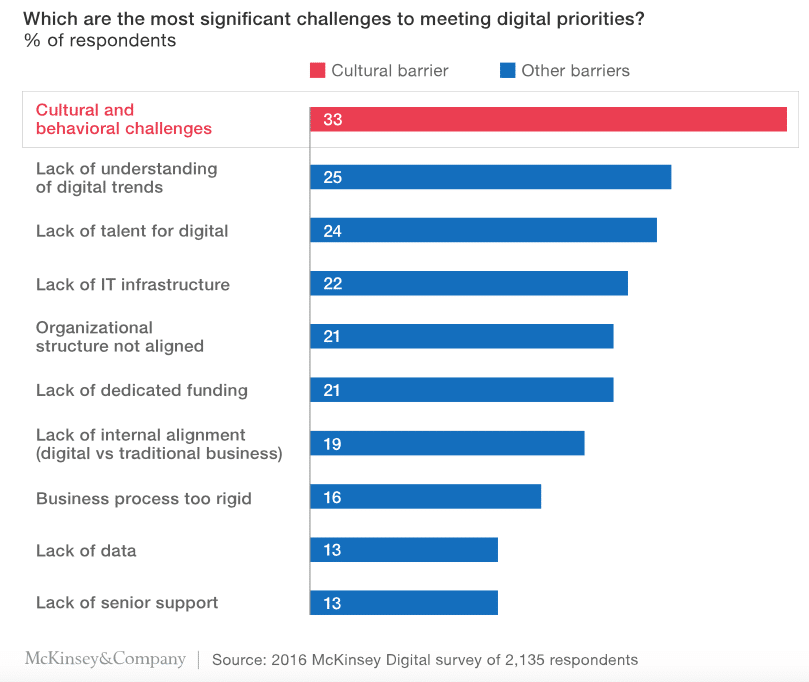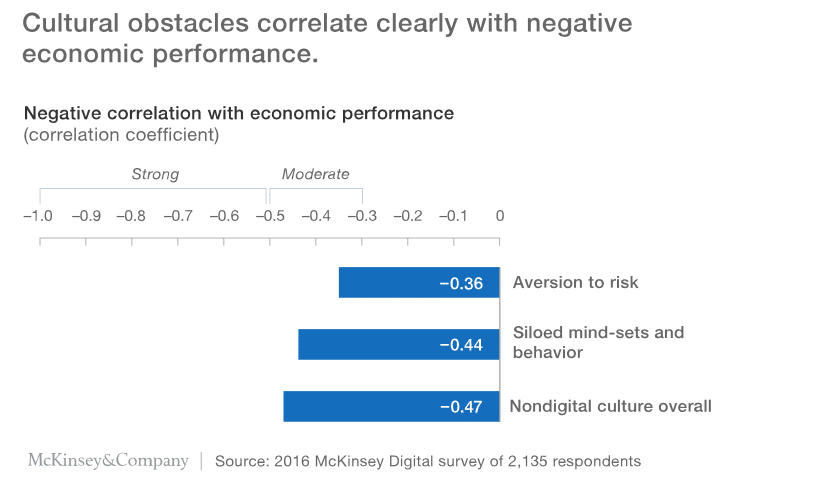
Why Digital Transformation Is Impossible Without an Engaging Culture
Digital transformation is essential for the businesses of today to grow and succeed. Incorporating new technologies into business processes means your company can become more efficient, become more productive, and ultimately deliver more value to customers.
Digital transformation goes beyond simple modernization. In many cases, it fundamentally changes the way an entire business operates.
New technologies bring new opportunities, and yet research shows that the majority of business transformations (around 70 percent) fail.
The main reason for this shocking rate of failure? Business leaders focus on the technologies and strategy without ensuring that the corporate culture also undergoes a transformation.
Quick Takeaways:
- Without a cultural evolution to match, most digital transformation strategies are doomed to failure before they even begin.
- Critical aspects of a supportive culture include openness to change and risk.
- Shifting to a customer-centric model is key – consider how technology can actually create better customer experiences rather than its list of features.
A 2016 McKinsey research study found that culture was the biggest challenge to companies trying to achieve their digital priorities, and a 2018 survey of businesses in the retail industry found that 80 percent of digital leaders had attempted to alter corporate culture in order to support digital transformation.

Company Culture Must Drive Digital Transformation
In those companies that have successfully undergone digital transformation, there is often a common factor: the company culture shift came first, and the organizational and strategic changes needed to support the digital transformation came later.
Culture-driven transformation means taking advantage of the most positive aspects of your organization’s culture to drive change, while at the same time identifying and improving its weakest parts.
Company culture must be aligned with its digital strategy for success. If change is needed, the companies that grow and thrive are those that embrace this change and commit to it fully.
Not everyone naturally embraces change. But, members of the organization who resist change must learn to see the positives in change if the transformation is to succeed. This is particularly important for those at executive and C-suite level.
Overcoming resistance to change is the first step in successfully driving digital transformation. Once you have the people in your company on your side, the hardest part is over. A company that has a culture and people that thrive in and welcome an environment of constant change is well suited for the rapidly evolving digital landscape of today.
How to Make Your Company Culture More Open to Change
This all sounds fine on paper, but how do you practically go about changing organizational culture?
This task is often more of a challenge for large businesses in traditional industries that have been operating for years. Small startups are naturally skilled at adapting to a rapidly changing environment – they have to be chameleons to survive. But, established companies with entrenched business processes that have remained unchanged for many years will naturally find adapting more difficult.
Start by focusing on your people.
When your employees feel that their thoughts, opinions, and feelings matter, they’ll be more open to adapting. A little empathy can go a long way. Change can be frightening, especially when you’ve been used to doing your job in a certain way for many years.
Employees may worry that they don’t have the skills to keep up with new technology, or even that they’re unable to learn it. Others may be worried that AI and automation technology may take their jobs. By understanding your employees’ fears and concerns and demonstrating that you’re willing and available to help them through the transition, you can help to overcome resistance.
It’s also important to involve your staff in the digital transformation process. Don’t steamroller through their established procedures and processes and expect them to be happy about it. For transformation to be successful, it’s vital to understand your employees’ challenges and stumbling blocks and how you can help them to overcome these challenges, not introduce more of them.
Make sure you actually implement ideas and suggestions from the feedback your employees are giving you. Individuals who take the risk of making suggestions will quickly learn that their ideas and opinions are not valued if nothing is done with the information they offer.
Cultivating a Risk-Tolerant Culture
Companies that avoid risks, always sticking with their tried-and-true strategies, can never evolve.
To undergo a successful digital transformation, corporate culture must actively encourage employees to take risks without fear of negative consequences.
Facebook founder, Mark Zuckerberg, has been candid in his advice for would-be entrepreneurs by explaining how his appetite for risk led to his success: “The biggest risk is not taking any risk. In a world that’s changing really quickly, the only strategy that is guaranteed to fail is not taking risks.”
This advice is sound not only for small startups and solopreneurs but also for businesses of any size. Companies that fail to experiment and try new strategies run the risk of stagnating and falling behind their competitors.

Shifting Focus to the Customer
As well as being open to change and encouraging calculated risks, organizations must develop a customer-centric culture to succeed in the digital age.
Technology has enabled the businesses of today to be more efficient and productive, but it has also increased customer expectations.
Customers have grown to expect excellent user experiences, personally tailored to their own unique needs and preferences. Data collection and technology makes this possible, but organizations must also ensure their culture is shifted to focus on the needs of the customer rather than the needs of the business.
Bad user experiences are estimated to cost businesses trillions of dollars through lost revenue and abandoned projects.
To succeed in today’s rapidly changing environment, businesses must consider the customer in each of their core processes, from product design through to sales, marketing, and customer service.
There’s no point in building a strategy around the latest technology if it doesn’t actually solve the customers’ problems. By building a customer-centric culture and considering the customer first, digital initiatives have a significantly greater chance of succeeding.
Final Thoughts
Technology is a tool, not a panacea. Of course, technology is a critical part of any digital transformation, but it’s not the only or even the most important part.
Building a strong culture that embraces change, is open to taking risks, and puts the customer at the heart of everything is the key to a successful digital transformation.
Ready to join the digital content revolution? If you are ready to get more traffic to your site with quality content that’s consistently published, check out our Content Builder Service. Set up a quick consultation, and I’ll send you a free PDF version of my books. Get started today and generate more traffic and leads for your business.







Excellent & clear explanation of a complex subject. And as you say, its all much easier said than done. Absolute commitment from the top is required to have any chance at succeeding – this type of organizational change cannot be left to middle managers as the hidden opposition can too easily undermine change efforts.
Thanks Randy. I appreciate the support. If you want to hear some of my thoughts on how anyone in the org can lead some of this change head on over to MeanPeopleSuck.com